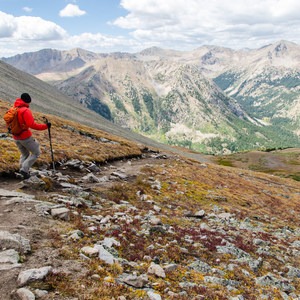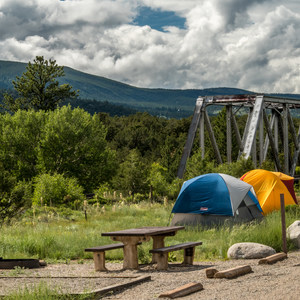Completed in 1987, the Colorado Trail stretches 485 magnificent miles from Denver to Durango. Along the way it meanders through high alpine mountains and valleys, offering a glimpse at some of the finest terrain Colorado has to offer. It traverses eight mountain ranges, six wilderness areas and stays above 10,000’ for the majority of the trail. Highlights include the Collegiate Range, where multiple 14ers are just off trail and can easily be climbed, and the San Juans, where the trail remains above tree line for days at a time and climbs to elevations of over 13,000’. There is also abundant wildlife along the Colorado Trail, ranging in size from small pika and marmot, to bear and moose.
The trail is divided into 28 different segments, each beginning at a trailhead accessible by vehicle. This accessibility is what makes the Colorado Trail special. Day hikers and section hikers can easily find their way to new segments of trail, while thru hikers can still enjoy a wild and rugged four to six week journey. Below is a description for Colorado Trail Collegiate West Segment 2.
Collegiate West Segment 2 begins from near the Sheep Gulch Trailhead. The first stretch of trail is fairly mellow and enjoyable as it skirts around the mountainside and parallels a nearby road, passing close to some historic mining areas.
The trail begins to climb slightly as it follows the South Fork of Clear Creek up a valley. You’ll enter the Collegiate Peaks Wilderness Area, and have stunning views of the Three Apostles Mountains in the near distance.
Eventually, after a big climb, you’ll leave the dense forest and rise above tree line. You’ll see a short spur trail to Lake Ann - be sure to take the time to check out this beautiful lake. The Colorado Trail then ascends Lake Ann Pass. The hiking is very rocky and steep in areas. During early summer there is often a cornice that lingers near the top of the pass, sometimes making an ice axe and micro spikes required.
After enjoying the fantastic view from the top of Lake Ann Pass, you’ll then begin a long descent. After dropping back into the forest don’t be surprised if you see dirt bikers on this stretch of trail as they are allowed. You’ll then descend, sometimes steeply, through some aspen forest. The trail then drops down to a meadow/wetland area along Texas Creek. This area is prime habitat for moose, be sure to keep an eye open.
The following mile or two are relatively flat and enjoyable hiking along the creek until you begin a big climb toward Cottonwood Pass. You’ll start to get back into more exposed and mountainous terrain as you near the highway.
Upon reaching Cottonwood Pass you will likely be met by large groups of tourists and day hikers. This is only one of two paved roads that the Collegiate West Route crosses. From here hikers can hitch east into Buena Vista if in need of resupply or rest.
































Comments
Sign In and share them.